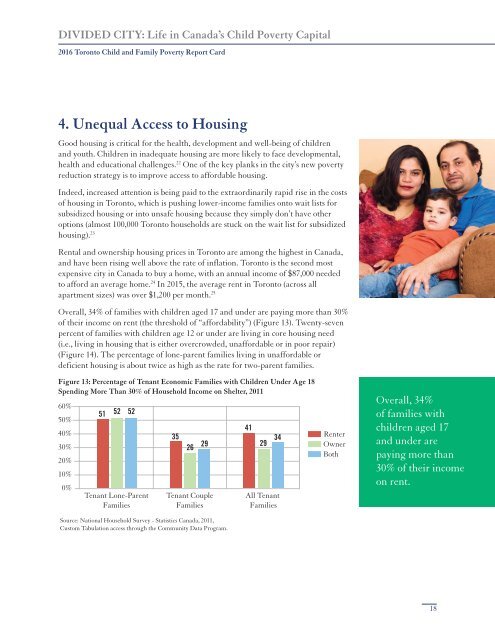Divided City Life In Canada's Child Poverty Capital
You also want an ePaper? Increase the reach of your titles
YUMPU automatically turns print PDFs into web optimized ePapers that Google loves.
DIVIDED CITY: <strong>Life</strong> in Canada’s <strong>Child</strong> <strong>Poverty</strong> <strong>Capital</strong><br />
2016 Toronto <strong>Child</strong> and Family <strong>Poverty</strong> Report Card<br />
4. Unequal Access to Housing<br />
Good housing is critical for the health, development and well-being of children<br />
and youth. <strong>Child</strong>ren in inadequate housing are more likely to face developmental,<br />
health and educational challenges. 22 One of the key planks in the city’s new poverty<br />
reduction strategy is to improve access to affordable housing.<br />
<strong>In</strong>deed, increased attention is being paid to the extraordinarily rapid rise in the costs<br />
of housing in Toronto, which is pushing lower-income families onto wait lists for<br />
subsidized housing or into unsafe housing because they simply don’t have other<br />
options (almost 100,000 Toronto households are stuck on the wait list for subsidized<br />
housing). 23<br />
Rental and ownership housing prices in Toronto are among the highest in Canada,<br />
and have been rising well above the rate of inflation. Toronto is the second most<br />
expensive city in Canada to buy a home, with an annual income of $87,000 needed<br />
to afford an average home. 24 <strong>In</strong> 2015, the average rent in Toronto (across all<br />
apartment sizes) was over $1,200 per month. 25<br />
Overall, 34% of families with children aged 17 and under are paying more than 30%<br />
of their income on rent (the threshold of “affordability”) (Figure 13). Twenty-seven<br />
percent of families with children age 12 or under are living in core housing need<br />
(i.e., living in housing that is either overcrowded, unaffordable or in poor repair)<br />
(Figure 14). The percentage of lone-parent families living in unaffordable or<br />
deficient housing is about twice as high as the rate for two-parent families.<br />
Figure 13: Percentage of Tenant Economic Families with <strong>Child</strong>ren Under Age 18<br />
Spending More Than 30% of Household <strong>In</strong>come on Shelter, 2011<br />
60%<br />
50%<br />
40%<br />
30%<br />
20%<br />
10%<br />
0%<br />
51 52 52<br />
Tenant Lone-Parent<br />
Families<br />
35<br />
26<br />
29<br />
Tenant Couple<br />
Families<br />
Source: National Household Survey - Statistics Canada, 2011,<br />
Custom Tabulation access through the Community Data Program.<br />
41<br />
29<br />
34<br />
All Tenant<br />
Families<br />
Renter<br />
Owner<br />
Both<br />
Overall, 34%<br />
of families with<br />
children aged 17<br />
and under are<br />
paying more than<br />
30% of their income<br />
on rent.<br />
18

















